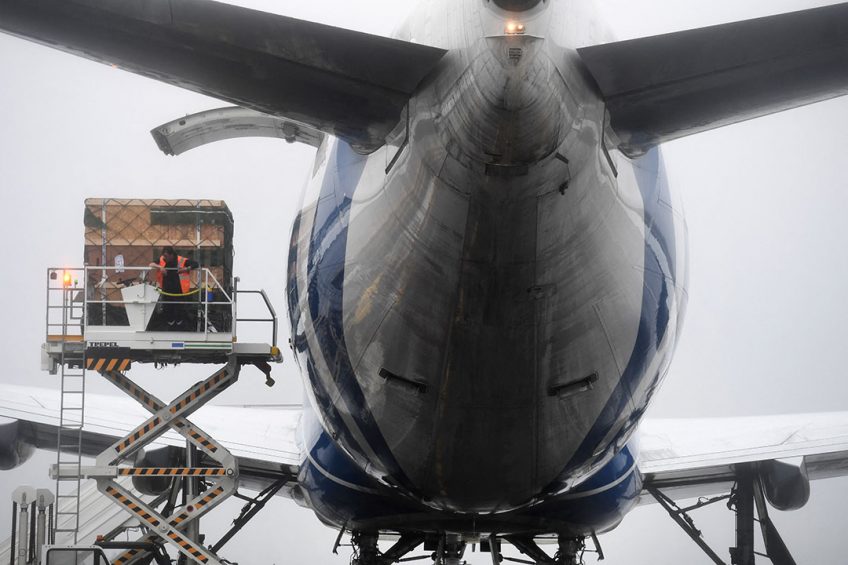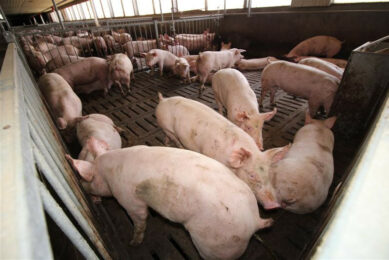Wanted: Millions of sows for China

The reconstruction of China’s pig industry, which was ruined by African Swine Fever (ASF), will take off at a much faster speed in 2021 than it did last year. International breeding organisations are gearing up to get their share as the Chinese market is virtually insatiable. What is the situation early 2021?
Also for breeding organisations there are only 24 hours in a day, yet they would wish they had more. In an attempt to restock China with sufficient amounts of breeding animals, it’s easy to get the impression that the Asian giant is all that matters.
Take for instance French genetics company Choice. In both France as well as the United States the company adjusted its breeding programme to be able to accommodate the Chinese market. What’s more, in France capacity has been expanded to be able to produce additional breeding material, primarily for China, says Jim Schirmer, the company’s director business development Asia.
They are not an exception, as these days, every breeding company is keen to increase its stakes in China, a country with a virtually unsatiable market. Before African Swine Fever (ASF) entered the country in 2018, China had roughly 45 million sows. It is estimated that half of them disappeared, either directly due to the virus or indirectly through culling. What is clear is that China will need whopping amounts of production sows in the next few years.
Pork production in China on the rise
Pork production in China is on the rise as we speak. Ernst van Orsouw, global director of strategy and marketing at Genus/PIC, estimates that more of half of the sows in China these days have been “promoted” from the finisher barns. In other words – these sows are not F1 animals, but finisher pigs not being as productive or proliferative. In due course, those sows will have to make way for F1 sows, whilst regular replacement of sows is continuing.
Hendrix Genetics reports that it aims to increase its position in China. Over the last few years, a start has been made to expand the number of breeding animals. That was only a relative small step. More investments will follow, directly aimed at the Chinese market, but at this stage the company cannot comment any further.

Read also: Chinese tech giant Huawei goes into pigs
In addition, French company Axiom is investing strongly in the Chinese market, says export sales representative Sigrid Willems. The company is also selling genetics to Chinese customers so they can start building their own in farm breeding programme. In China, Axiom will supervise these in-farm breeding programmes. In addition, Axiom has a local foot on the ground so semen can be easily exported to China.
Amounts of breeding pigs transported
The export targets confirm this tendency of breeding companies strengthening their position on the Chinese market, see Table 1. In total, across all breeding companies, in 2020 alone almost 28,000 great-grandparent (GGP) pigs were shipped to China, according to French breeding company Nucléus. Most of these were sent from France and Denmark.
With 28,000 exported GGP animals per year, there is a solid basis to help China achieve sufficient levels of production sows. In case the 2020 numbers would be achieved three years in a row, and taking into account some annual growth as well, by late 2022 there could roughly be 100,000 GGP animals shipped to China. With that amount of GGP animals it is theoretically possible to produce 20 million F1 sows in the longer run.
Not every breeding company has been sharing information about their intentions or plans for 2021. Nucléus says in 2020 the company took care of almost 25% of the 28,000 (about 6,300 animals of which over 5,000 Large White sows). In 2021, the company aims to ship a similar amount to China. Julien Rogon, the company’s export manager expects an amount of 10,000 animals to be feasible as well.

Choice is accelerating in 2021. The company is striving to export at least 14,000 breeding pigs to China in 2021, equivalent to ten times their amount of 2020. That year, the company was preparing and adjusted its breeding goals for China.
Axiom also sees potential growth, aiming to transport 9,000 GGP pigs to China in 2021. The first shipment already was made, the first 2,000 of Axiom breeding pigs were shipped to Guiyang in central-southern China in three planes. These animals embarked at Brest airport in Western France.
Growth and pig health in China
Repopulation is one thing, disease pressure is another. The breeding companies active in China, however, all notice that the awareness about biosecurity on Chinese pig farms has strongly increased ever since ASF entered the country in August 2018. Should the virus be detected on a farm, it usually happen in a pretty early stage, leading to the depopulation of only a part of the pig inventory.
Still ASF virus is strongly present in China. Also pig production companies do continue getting infected with ASF. On farms in infected areas, all staff will have to comply for the full 100% with hygiene measures to avoid the introduction of the virus. One mistake could have catastrophic consequences.
On top, there are other challenges. The cold for instance, as during winter temperatures drop to below 0°C in northern China, ideal for viruses to thrive. In addition, ASFv is not the only pathogen – others do prevail too, for instance Porcine Epidemic Diarrhoea virus.
Add to that the use of finisher pigs in the breeding phase, with piglets born being weaker in general, and the cocktail is risky to say the least.
In short, the question when China’s pig production will be completely back on track is difficult to answer. The uncertainty is huge, and China’s pig industry will most likely have to live with the fact that it will have to produce pig meat in an area where the ASF virus will be endemic.

In 2020, Pig Progress published a first overview of breeding pigs shipped to China
Production recovery in 2024
Yet projections and plans are being made, not in the least by the Chinese authorities themselves. By the end of last year, Beijing once more called for a rapid recovery of pig meat production, hoping that for consumers prices will decrease, leading to lower inflation levels. Companies now present in China do notice that the recovery of the pig sector has been accelerating since late last year.
China like no other country in the world is capable of the renaissance and facilitation of a sector in a relatively short amount of time. Rabobank expects that by 2024, the Chinese pig meat production will be back at the pre-ASF levels. Breeding organisations active in China have by and large agreed to the bank’s projections. Hendrix Genetics representatives add that in the entire Chinese pig industry there is great determination to achieve targets set to reconstruct the industry.
Van Orsouw, PIC, discerns 2 different phases in this surge. The first includes the growth of the amount of sows. The second is the improvement of sow productivity. Especially for the second phase, China still has a long way to go. He says that Chinese pig farms have huge difficulty to find sufficient amount of capable staff needed for these expansion plans. Dutch animal nutrition company Agrifirm recently estimated that average production in China is most likely below 20 piglets weaned per sow per year.
Continuation to invest
It is fair to conclude that in the next few years, China will continue to invest in strengthening its own breeding structure. Hendrix Genetics deduces that tendency from the willingness of Chinese state and private companies to start joint ventures with international breeding companies. Due to the disease pressure, pig breeding in China has known its ups-and-downs, with many important lessons learnt. Nucléus has proven that it is possible to maintain SPF levels at a nucleus farm.
The French breeder, however, expects that importing breeding pigs will continue to stay necessary for China. Putting the Chinese initiatives into perspective, export manager Rogon remarks that this message of China developing its own breeding sector has been repeated frequently over the last 20 years, without actually getting close to achieving it. For now the demand to pork is so large, that importing of breeding pigs will be of major importance in getting the shelves filled.
Continuous need for pig meat imports
It is expected that the Chinese imports reached their zenith in 2020. Rabobank states that China imported 5.6 million tonnes of pig meat and related products, which is an 85% year-on-year increase. For 2021, it is expected there will be a drop in imports between 10-30%, resulting from a growing domestic production. Pigmeat exporting countries are going to notice that, Rabobank writes. Just to give an idea: in case China would import 1 million tonnes fewer pork, then that is similar to the annual production of Belgium.
Breeding companies agree with the Rabobank estimates, even though all projections are surrounded by uncertainty. China will most likely continue to import pig meat products, even when the domestic production would return to pre-ASF levels. There will be a continuous demand to offal anyway in China. Prior to ASF, China imported 2.5 million tonnes of meat and offal.
New pig farm construction sites
Probably exemplary of the reconstruction of the Chinese pig sector is what is being built by Muyuan Foods. Late 2020 the news broke that Muyuan is building very probably the largest pig farm in the world, in Nanyang, central China. Close to that city a farm is being constructed for 84,000 sows with weaned piglets, in 21 pig houses.
It is a risky step, as the large farms are certainly not immune for ASF and other pig diseases going round in China. The company’s plans are therefore often followed by insiders with a certain level of scepticism. Large farms, however, do increasingly take care of pork production in China. High prices for pigs makes investing relatively easy. Last January, the Chinese pig price was high with € 4.89/kg liveweight.
Rabobank projects that this price will drop to € 3/kg, as increasing production will push prices down. On the longer term, further price drops will be a risk for these large companies. Their cost price is around € 2.55/kg meat. There will be a moment that the increased production will lead to revenue prices sinking below cost price. Then losses could suddenly add up.











